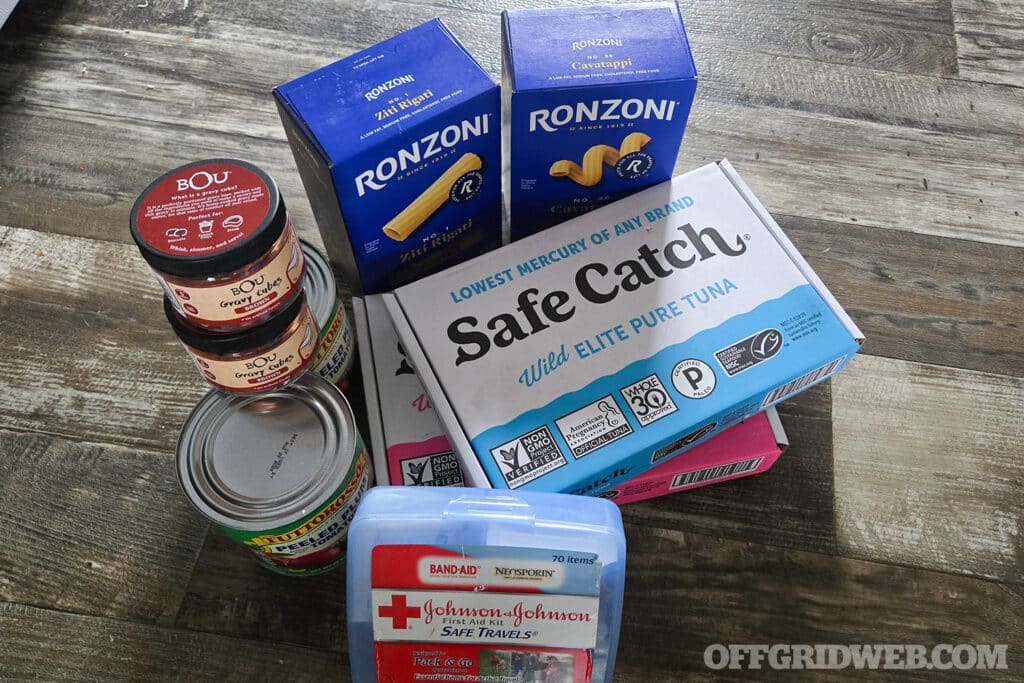RECOIL OFFGRID Preparation Supply Chain Disruptions
In This Article
The modern supply chain is a complex web that is responsible for the production and distribution of all the supplies used in modern society. This web involves coordination between suppliers, manufacturers, transportation companies, retail stores, and even governments to facilitate international trade. Beyond the coordination between many businesses and organizations, it also relies heavily on our infrastructure, like roads and bridges as well as utilities such as power and water. Not only does this supply chain ensure we have access to life-sustaining essentials, but it also fuels global industry, utilities, hospitals, military operations, and just about anything else you can think of. Each part of the supply chain is vital to keeping the flow of goods moving to the next part and a failure in just one cog in the wheel can lead to supply chain disruptions that have a profound impact on our communities.
Despite the complexity of this fragile system, most people will not give it much thought on a day-to-day basis. We have become comfortable with simply going to the store or clicking a few buttons on the internet to access crucial supplies we need and the very many luxury items that modern life has afforded us. This level of complacency can be dangerous, especially seeing firsthand the impact disruptions in the supply chain can have on us as individuals and the communities we live in.
A majority of people can deal with the economic impact of minor supply chain disruptions. Higher prices based on a temporary disruption will not impact the wealthy, and those who are unwilling or unable to pay the higher prices will often seek alternative items. But what happens when a more serious disruption occurs on a regional, national, or even international level?

What was once a minor inconvenience can quickly turn into a devastating issue that can lead to serious consequences. In some cases, long-term supply shortages have driven prices of essential items to prices that are unmanageable for many and have even led to these essential items being inaccessible for extended periods. This often leads to panic and desperation, increasing crime rates, and even leading to civil unrest.
Many of us have experienced this to some degree or another throughout our lifetimes. Despite this, many of us quickly forget these experiences, and quickly fall back into complacent lifestyles that rely solely on these supply chains to get us what we need.
In the last two decades, several major disruptions have occurred. Unfortunately, it seems that every passing event is more severe than the last. While some of the events were regionally specific, the impacts were felt all over the United States. Issues like these have become widespread, and almost everyone has a story to tell about an event that disrupted their supply chain.

Northeast Grid Failure
In the early 2000s much of the Northeast experienced catastrophic power outages, impacting everything from grocery stores, public transportation, communications, and hospitals. While many institutions had backup generators, the systems were antiquated, and many of those backup systems failed.
Over the course of 4 days, frozen and refrigerated foods spoiled in homes and stores, gas pumps were largely non-functional, and the use of debit or credit cards in stores and ATM’s was impossible. Even if a store was open to sell non-perishable food, unless you had cash on hand, you could not buy anything. After a few days, the power came back online, and people moved on with their lives without much thought.

Superstorm Sandy
In 2012, we experienced Superstorm Sandy, which devastated many Caribbean countries and eventually made its way to the Mid-Atlantic states. On Long Island at the time, this storm destroyed much of our infrastructure, many areas were without power for weeks. Some surrounding areas were out even longer.
It is easy to forget that Long Island is an island until major bridges and ports were damaged, and getting food and other necessities into the grocery stores was impossible. Once again, electronic gas pumps were not functional, and even as certain areas began to get power back, fuel was in short supply. Long gas lines quickly led to frustrations, and it was common to hear news stories of people getting into physical altercations, and even events where people were being stabbed or shot over disputes about filling their gas tanks.

The Pandemic
After experiencing the effects of Superstorm Sandy, people started to become more preparedness-minded, but most of that wasn’t constructive or practical.
Enter the pandemic and panic buying.
The COVID-19 pandemic started in late 2019, and by early 2020, there was full-scale public panic. Many grocery store shelves sat barren of staples that people relied upon, and many of these shortages lasted for months.
Common items were in short supply from a combination of reduced supply from many businesses being closed and an increase in panic buying. Many grocery stores instituted purchase amount limits on key items to reduce panic buying and get much needed supplies into many peoples hands. These shortages and purchase limits continued for months and exacerbated an already high tension situation for people, especially those living in densely populated areas.
Supply chain disruptions during the pandemic extended well beyond pantry staples. Prescription medications were in short supply, which put many people at risk of serious health complications. Motor vehicle production ground to a halt due to shortages in circuit boards and other parts driving prices on new and used vehicles up. These supply chain disruptions were so severe that the impact is still felt in our economy today!

Current Events
Fast forward to today, an ongoing conflict between Russia and the Ukraine has driven the cost of grains and other staples through the roof. Many businesses are still recovering financially from the pandemic, and prices for fuel, transportation, and utilities, along with record inflation, have drastically increased prices of goods across the board.
Massive storms rocked the northeast and many southern states, destroying roads, bridges, and entire communities. Early in October, the Dock Workers Union organized a major strike that shut down nearly all the ports from Maine to Texas, meaning food, clothing, machine parts, and much more could not make it into the country from foreign sources.

With the threats of massive infrastructure destroying storms becoming more common, economic challenges making coping with rising prices more difficult, and workers becoming increasingly frustrated with their job conditions and pay rates, supply chain disruptions are likely to continue into the future.
While we may not have the ability to control the supply chain issues, each of us can be more prepared to handle minor and even major disruptions. With the proper mindset, a few ancestral skills, and the simple act of stocking up on key items we can ensure we have everything we need to get through the challenges of supply shortages, bring peace of mind to our loved ones, and encourage our local community to support one another.
Remember, like any other skill, preparedness is developed over time. Each piece of gear is helpful, but knowing how to use them properly and developing the proper mindset and skill set will take practice and time!

Rubik's cubes and assorted puzzle games are a favorite in our house. Games like this are not only fun, but they sharpen our minds
The most important tool or the greatest hindrance in any difficult situation is right between your ears. Your mind helps you make every decision in your life from something as mundane as what shoes to wear to major life decisions like choosing a place to live. The brain is such a powerful tool that even the most advanced computer on the planet does not even come close to matching its ability to process and store data.
Unfortunately for us, our brain has several unconscious defense mechanisms that are designed to keep us alive but can often lead to the opposite. The worst thing we can do in any difficult situation is panic and give in to irrational thoughts as it can often lead to hasty and poor decision-making.
There are a number of exercises we can do to help sharpen our minds and utilize logic-based thought, as well as exercises, that can help us focus and calm our minds through difficult situations.

Our households Emergency Plan Binder, along with some essential survival supplies that we keep easily accessible.
The old adage goes “failing to plan is planning to fail” and outside of moments of pure luck, this tends to be accurate. While it is next to impossible to account for every possible situation, having some basic plans of action will go a long way to help keep your mind focused and avoid panic.
Every person, household, and community is different, so no cookie-cutter plan will work for everyone. In a supply chain shortage, there are a few key factors that should be taken into account when developing your plan. While these are just a few points, these and many others will become more apparent as you begin to understand the other points on this list:

A few of the items we always keep on hand. Canned tuna, crushed tomato, pasta, and some basic first aid supplies.
Stockpiling is one of the easiest and most accessible ways to prepare for a supply chain shortage. The biggest challenge with stockpiling is storage space and available funds to purchase supplies. If you live in an urban setting, your space may be limited, but even keeping a few extra packages of essential items can ensure you get through a shorter supply chain issue. Here are some items that everyone should consider having in their stockpile, but this can be modified to suit your specialized needs.
An additional benefit to having a stockpile during a supply chain disruption is that it opens up the option of bartering with members of your community. This allows both parties to benefit from getting needed supplies and helps build bonds within the community!

Part of my personal foraging kit. Foraging can provide healthy plant options during supply chain disruption.
It’s time to tap into the modern version of the skills our ancestors relied upon to stay alive. While modern tools such as compound bows, composite fishing polls, and hunting rifles have made these tasks easier, there is still a need to develop skills to use these tools effectively. While we can't teach these skills in a few sentences, there are some essential skills that you should consider looking into.

Common recreational items like this bicycle and scooter can be used as faster then walking transportation when fuel becomes scarce.
Getting around through either personal vehicles or public transportation is often taken for granted, but as seen in the examples earlier in the article, supply chain issues can impact the availability of vehicle fuels. Having backup methods of transportation can help us move quickly in an emergency or just get where we need to go faster than walking.
Supply chain disruptions have become more prevalent in recent years with no signs of letting up. Taking control of our reaction to situations like this will ensure that we are prepared to survive and thrive even during long-term supply shortages. Sharpening our minds will ensure we are calm and focused during high-stress situations. Creating emergency plans for our household will provide a road map when the times get tough. Keeping extra stock of vital supplies can allow us to maintain a fairly normal lifestyle during short-term supply chain disruptions, and honing the skills our ancestors relied upon can carry us through long-term supply shortages. Having backup transportation options can help us cover distance when needed when fuel supplies are unavailable. It may seem difficult to accomplish this all, but take it one step at a time, and you will quickly find yourself feeling more confident and prepared to take on any challenge!
Don’t miss essential survival insights—sign up for Recoil Offgrid's free newsletter today!
Check out our other publications on the web: Recoil | Gun Digest | Blade | RecoilTV | RECOILtv (YouTube)
 STAY SAFE: Download a Free copy of the OFFGRID Outbreak Issue
STAY SAFE: Download a Free copy of the OFFGRID Outbreak Issue
No Comments